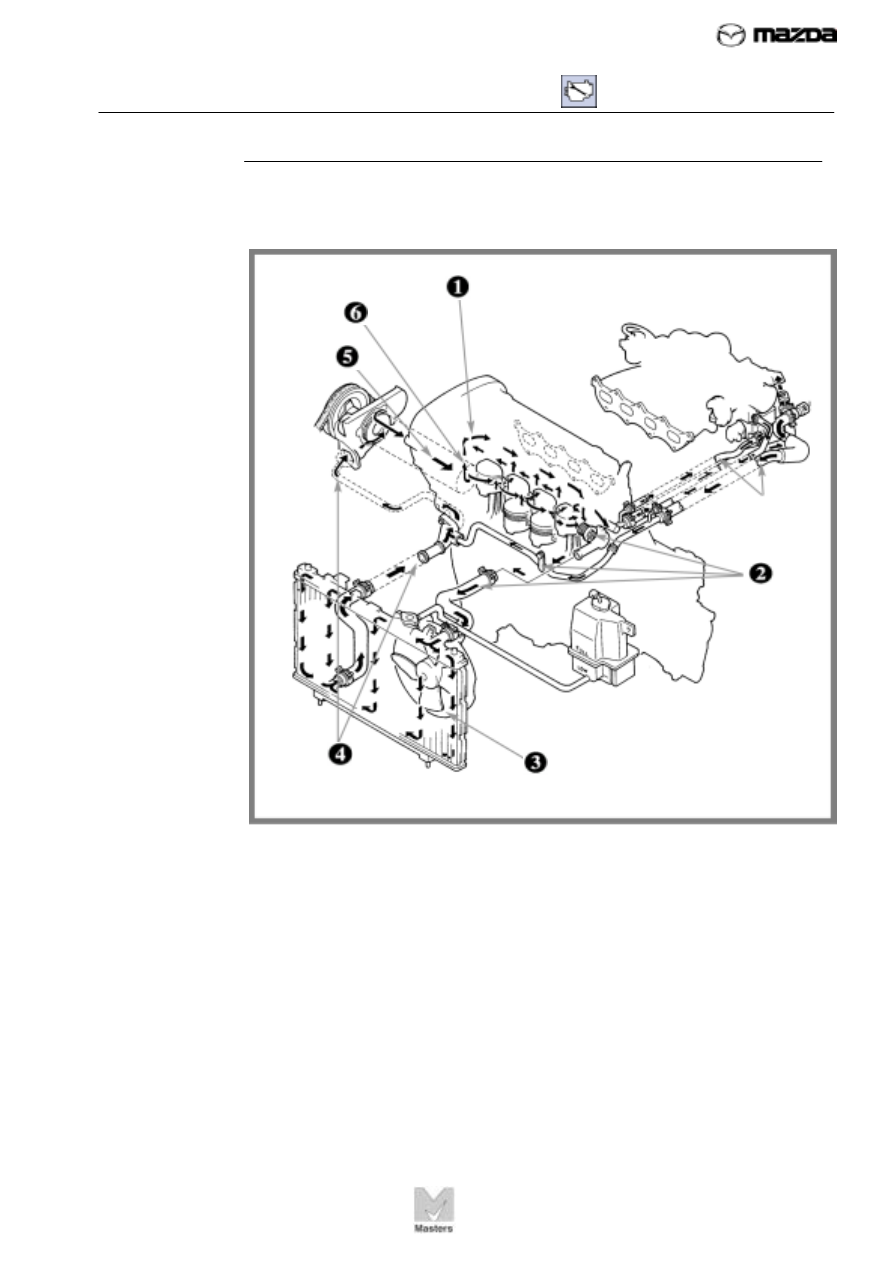Mazda Training manual — part 250

6 – COOLING SYSTEM
85
Piston Engine Fundamentals
TC010-05-01S
Water Pump
The water pump circulates coolant throughout the cooling system.
Coolant Passages
Coolant passages are cast into the cylinder block and cylinder head.
These passages carry coolant around the cylinders and combustion
chambers. The coolant picks up heat and carries it away from these
parts.
Thermostat
The thermostat regulates engine temperature by controlling the flow of
coolant until a certain preset temperature is met. This helps the engine
warm up quickly and maintain a more even temperature.
Radiator Reservoir
As coolant becomes hot, it expands. The coolant recovery system
stores the excess coolant released from the radiator. When the engine
cools, the coolant in the reservoir is drawn back into the cooling system.
This keeps the cooling system constantly full, increasing cooling system
efficiency.
Fan
The radiator fan pulls cool outside air over the radiator surface to pick
up heat from the coolant for faster heat transfer, especially during idling.
Models equipped with air conditioning usually have an additional fan for
increased cooling.
Pressure Cap
The pressure cap maintains pressure in the system which raises the
boiling temperature of the coolant, preventing the coolant from
evaporating or boiling off. This cap also allows excess pressure to
escape from the system.
Radiator
The radiator transfers heat from the coolant to the outside air. The
radiator core contains tubes and fins. Coolant flows through the tubes,
and the fins increase the radiator’s surface area exposed to the air. This
allows the air to carry away more heat, reducing the coolant
temperature.
Answers to Review
Exercise 7
1. oil strainer
2. main gallery
3. oil pan
4. rotor or trochoid
5. oil filter
6. B & D

6 – COOLING SYSTEM
86
Piston Engine Fundamentals
TC010-05-01S
FIGURE 57. Coolant
flows from the
cylinder head
passage through
the radiator and
water pump to the
cylinder block.
HOW COOLANT CIRCULATES
Figure 57 shows how coolant circulates through the cooling system. The
numbers in this figure match the numbered steps in the description that
follows.
To/from heater

6 – COOLING SYSTEM
87
Piston Engine Fundamentals
TC010-05-01S
When a cold engine is started, the water pump only circulates coolant through the
cylinder head and engine block coolant passages, quickly raising the engine
temperature.
When enough heat is created to open the thermostat, the water pump circulates
coolant throughout the engine and into the radiator.
The hot coolant flows from the upper tank of the radiator, to the lower radiator tank.
Cool air passing over the radiator fins removes heat from the coolant.
From the lower tank, coolant flows through the lower radiator hose to the water pump
inlet.
The water pump circulates the coolant through the pump outlet into the cylinder block
coolant passage.
Coolant flows from the cylinder block passage into the cylinder head coolant passage
to complete the circuit.
As Figure 57 also shows, some of the coolant may be diverted to the heating system, which
heats the passenger compartment of the vehicle.
WATER PUMPS
Most water pumps are impeller or non-positive displacement pumps. This means that all the
water that enters the pump does not necessarily have to come out of the pump. This design
is different from the oil pump (a positive displacement type), in which all the oil that enters
the pump is pumped out.
Impeller-Type Pump
Water pumps are usually designed as simple impeller-type pumps. Figure 58 shows the
parts of a typical impeller-type water pump.

6 – COOLING SYSTEM
88
Piston Engine Fundamentals
TC010-05-01S
FIGURE 58.
Water pumps are
simple impeller-
type pumps
.
Pump pulley
Shaft and
bearing
assembly
Pump body
Water seal
Impeller
Pump inlet
FIGURE 59.
Centrifugal force
pushes coolant
from the center of
the impeller to the
outside edges of the
impeller.
Pump inlet
Impeller
Pump outlet
The water pump has a pump body, which holds the impeller (also called
a vane or rotor). The impeller turns on a shaft that is connected to a
pulley driven by the crankshaft. The impeller shaft is supported by a
bearing. A water seal keeps coolant from leaking out of the pump. A worn
bearing or impeller shaft causes the seal to leak.
Centrifugal Operation
The impeller-type pump operates on centrifugal action, which is the
tendency of a rotating weight to be pushed outward. Coolant flows
through the pump inlet and enters the center of the impeller, as shown in
Figure 59. As the impeller rotates, it “slings” the coolant to the outside
edges of the impeller. The coolant is trapped by the pump body and
forced into the pump outlet.

Нет комментариевНе стесняйтесь поделиться с нами вашим ценным мнением.
Текст